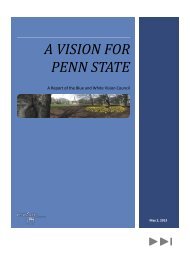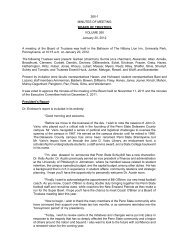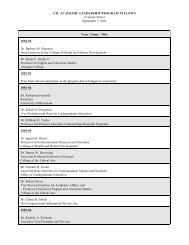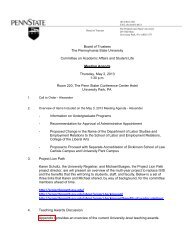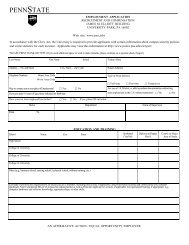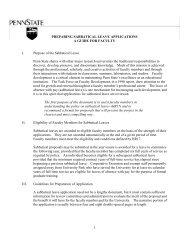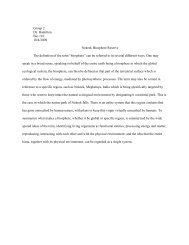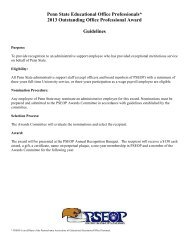Endowment & Similar Funds - Penn State University
Endowment & Similar Funds - Penn State University
Endowment & Similar Funds - Penn State University
You also want an ePaper? Increase the reach of your titles
YUMPU automatically turns print PDFs into web optimized ePapers that Google loves.
<strong>Endowment</strong> Performance Compared to Passive Portfolio<br />
The <strong>Endowment</strong>’s investment performance is measured against a hypothetical Passive Portfolio, comprised of three<br />
broad asset categories: Public Equities, Private Capital, and Fixed Income. This passive portfolio serves as a blended<br />
benchmark against which the performance of the actual, actively-managed <strong>Endowment</strong> is monitored. In the table<br />
below, the respective static weightings of the three major asset categories, along with respective sub categories, are<br />
associated with corresponding market benchmarks to generate Passive Portfolio returns over 1-, 3-, and 5-year<br />
horizons:<br />
- Annualized Benchmark Returns -<br />
Asset Class Benchmark Weighting 1 Year 3 Years 5 Years<br />
Public Equities (listed on stock exchanges)<br />
US Equities S&P 500 Index 40% 15.1 -2.9 2.3<br />
Non-US Equities All Country World ex US Index 15 11.6 -4.6 5.3<br />
Private Capital (non-marketable alternatives)<br />
Private Equity CA Private Equity Composite 15% 18.0 0.9 10.4<br />
Venture Capital CA Venture Capital Composite 5 8.3 -2.1 4.6<br />
Private Real Estate NCREIF Index 5 5.8 -4.6 3.7<br />
Fixed Income/Cash<br />
Total US Bonds Barclays Aggregate Bonds 20% 6.5 5.9 5.8<br />
Total Passive Portfolio (net) 100% 12.5% -0.9% 4.8%<br />
Note: the above categories / sub-categories are very broad and are assumed to be constant over the entire 5-yr period,<br />
much like a traditional balanced portfolio. As shown on the previous page, the actual endowment portfolio is<br />
comprised of several separate portfolios whose periodic weights vary as a result of fluctuating market returns.<br />
12.5%<br />
14.1%<br />
<strong>Penn</strong> <strong>State</strong> <strong>Endowment</strong> vs Passive Portfolio<br />
4.8%<br />
5.6%<br />
Passive Portfolio<br />
PSU <strong>Endowment</strong><br />
-0.9%<br />
-0.3%<br />
1 Year 3 Year 5 Year<br />
As shown above, <strong>Penn</strong> <strong>State</strong>’s <strong>Endowment</strong> returned<br />
14.1% net for calendar 2010, surpassing the 12.5%<br />
return of the Passive Portfolio. For the trailing 3- and<br />
5-years, the Passive Portfolio would have realized<br />
annualized returns of -0.9% and 4.8%, respectively.<br />
By comparison, the <strong>Endowment</strong>’s actual 3- and 5-year<br />
returns outperformed in each period, netting -0.3% and<br />
5.6%, respectively. Overall, this shows that the<br />
<strong>Endowment</strong>’s investment managers augmented the<br />
performance relative to passive benchmarks.<br />
The Passive Portfolio provides a guidepost to help achieve long-term results that are consistent with the twin<br />
objectives of purchasing-power preservation, along with stable endowment spending. The <strong>Endowment</strong>’s performance<br />
varies from the static Passive Portfolio as a consequence of several factors, including but not limited to the following:<br />
timing of cash-flows into and out of the <strong>Endowment</strong>, tactical shifts in asset mix, and individual investment manager<br />
performance.<br />
6



